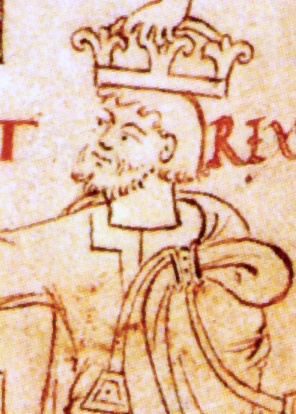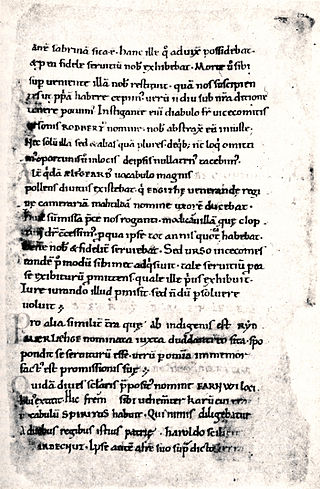
Æthelred II, known as Æthelred the Unready, was King of the English from 978 to 1013 and again from 1014 until his death in 1016. His epithet comes from the Old English word unræd meaning "poorly advised"; it is a pun on his name, which means "well advised".

Emma of Normandy was a Norman-born noblewoman who became the English, Danish, and Norwegian queen through her marriages to the Anglo-Saxon king Æthelred the Unready and the Danish king Cnut the Great. A daughter of the Norman ruler Richard the Fearless and Gunnor, she was Queen of the English during her marriage to King Æthelred from 1002 to 1016, except during a brief interruption in 1013–14 when the Danish king Sweyn Forkbeard occupied the English throne. Æthelred died in 1016, and Emma married Sweyn's son Cnut. As Cnut's wife, she was Queen of England from their marriage in 1017, Queen of Denmark from 1018, and Queen of Norway from 1028 until Cnut died in 1035.

Cnut, also known as Canute and with the epithet the Great, was King of England from 1016, King of Denmark from 1018, and King of Norway from 1028 until his death in 1035. The three kingdoms united under Cnut's rule are referred to together as the North Sea Empire.

Edmund Ironside was King of the English from 23 April to 30 November 1016. He was the son of King Æthelred the Unready and his first wife, Ælfgifu of York. Edmund's reign was marred by a war he had inherited from his father; his cognomen "Ironside" was given to him "because of his valour" in resisting the Danish invasion led by Cnut.
Leofwine was appointed Ealdorman of the Hwicce by King Æthelred the Unready of England in 994. The territory of the Hwicce was a kingdom in the Western Midlands in the early Anglo-Saxon period, which soon became a subdivision of Mercia. Leofwine was the son of Ælfwine, who is otherwise unknown, but the family appears to have originated in the East Midlands. Leofwine and his sons were considered by the See of Worcester as spoliators who seized church land, but East Midlands religious establishments regarded them as benefactors.

Eadric Streona was Ealdorman of Mercia from 1007 until he was killed by King Cnut. Eadric was given the epithet "Streona" in Hemming's Cartulary because he appropriated church land and funds for himself. Eadric became infamous in the Middle Ages because of his traitorous actions during the Danish re-conquest of England.

The Battle of Brentford was fought in 1016 between invading forces of the Kingdom of Denmark under Cnut and the defending forces of the Kingdom of England led by Edmund Ironside. The battle was fought as part of a campaign by Cnut to conquer England. The battle was a victory for the English, who nevertheless lost a large number of men.
Ælfric was Ealdorman of Hampshire from c. 982 to 1016.

The history of Anglo-Saxon London relates to the history of the city of London during the Anglo-Saxon period, in the 7th to 11th centuries.

Eadnoth the Younger or Eadnoth I was a medieval monk and prelate, successively Abbot of Ramsey and Bishop of Dorchester. From a prominent family of priests in the Fens, he was related to Oswald, Bishop of Worcester, Archbishop of York and founder of Ramsey Abbey. Following in the footsteps of his illustrious kinsman, he initially became a monk at Worcester. He is found at Ramsey supervising construction works in the 980s, and around 992 actually became Abbot of Ramsey. As abbot, he founded two daughter houses in what is now Cambridgeshire, namely, a monastery at St Ives and a nunnery at Chatteris. At some point between 1007 and 1009, he became Bishop of Dorchester, a see that encompassed much of the eastern Danelaw. He died at the Battle of Assandun in 1016, fighting Cnut the Great.
UlfcytelSnillingr, or Snylling, was an Anglo-Saxon nobleman. He was apparently the ealdorman of East Anglia from 1004 to his death at the Battle of Ashingdon in 1016, although he is not called an ealdorman in any of the charters he witnessed. Scandinavian sources refer to him as Ulfkell Snillingr, the byname meaning bold.
Events from the 1010s in England.
Ælfgifu of York was the first wife of Æthelred the Unready, King of the English; as such, she was Queen of the English from their marriage in the 980s until her death in 1002. They had many children together, including Edmund Ironside. It is most probable that Ælfgifu was a daughter of Thored, Earl of southern Northumbria and his wife, Hilda.
Ælfhelm was the ealdorman of Northumbria, in practice southern Northumbria, from about 994 until his death. An ealdorman was a senior nobleman who governed a province—a shire or group of shires—on behalf of the king. Ælfhelm's powerful and wealthy family came from Mercia, a territory and former kingdom incorporating most of central England, and he achieved his position despite being an outsider. Ælfhelm first appears in charters as dux ("ealdorman") in about 994.
Northman was a Mercian chieftain of the early 11th century. A member of a powerful Mercian kinship (clan), he is known primarily for receiving the village of Twywell in Northamptonshire from King Æthelred II in 1013, and for his death by order of King Cnut the Great (Canute) in 1017. His violent end by Cnut contrasts with the successful career enjoyed by his brother Leofric, as Earl of Mercia during Cnut's reign. Northman is believed to have been an associate of the troublesome ealdorman Eadric Streona, who was killed with him.

The North Sea Empire, also known as the Anglo-Scandinavian Empire, was the personal union of the kingdoms of England, Denmark and Norway for most of the period between 1013 and 1042 towards the end of the Viking Age. This ephemeral Norse-ruled empire was a thalassocracy, its components only connected by and dependent upon the sea.

Very little is known for certain of the ancestry of the Godwins, the family of the last Anglo-Saxon king of England, Harold II. When King Edward the Confessor died in January 1066 his closest relative was his great-nephew, Edgar the Ætheling, but he was young and lacked powerful supporters. Harold was the head of the most powerful family in England and Edward's brother-in-law, and he became king. In September 1066 Harold defeated and killed King Harald Hardrada of Norway at the Battle of Stamford Bridge, and Harold was himself defeated and killed the following month by William the Conqueror at the Battle of Hastings.

The Danish House of Knýtlinga was a ruling royal house in Middle Age Scandinavia and England. Its most famous king was Cnut the Great, who gave his name to this dynasty. Other notable members were Cnut's father Sweyn Forkbeard, grandfather Harald Bluetooth, and sons Harthacnut, Harold Harefoot, and Svein Knutsson. It has also been called the House of Canute, the House of Denmark, the House of Gorm, or the Jelling dynasty.

Edmund Ætheling was a son of Edmund Ironside, who briefly ruled as King of England following the death of his father Æthelred the Unready in April 1016. Edmund Ironside fought the invasion of the Danish Vikings, but when he died in November 1016 their leader Cnut became the undisputed king of all England.

In the autumn of 1016, the Danish prince Cnut the Great (Canute) successfully invaded England. Cnut's father, Sweyn Forkbeard, had previously conquered and briefly ruled England for less than five weeks.













